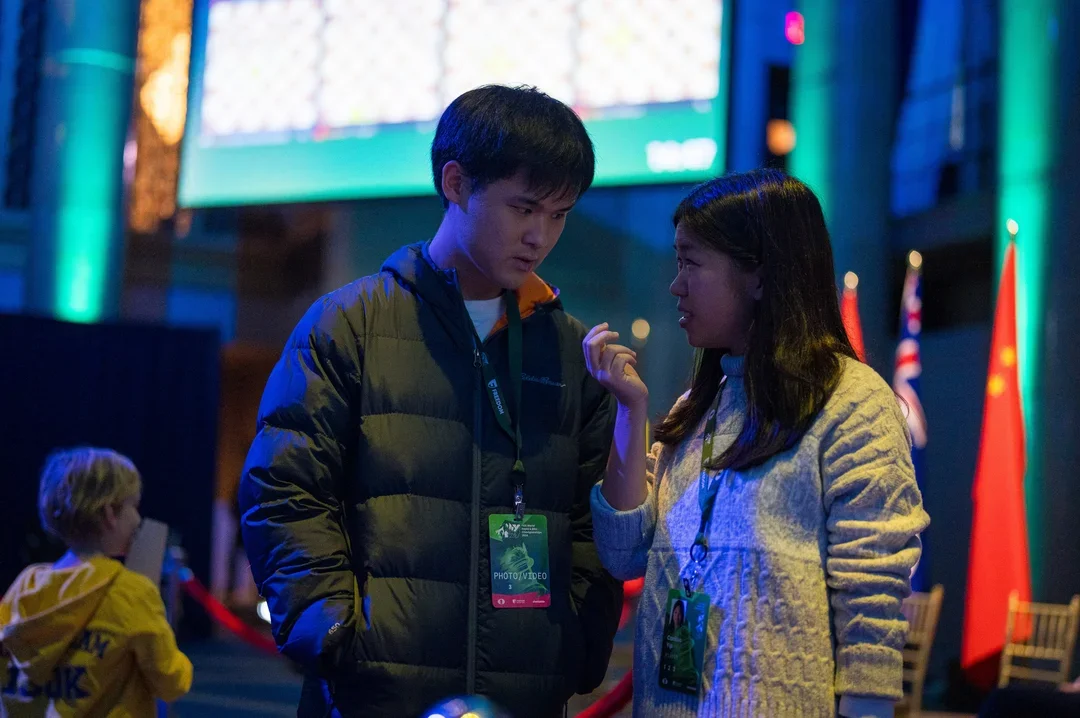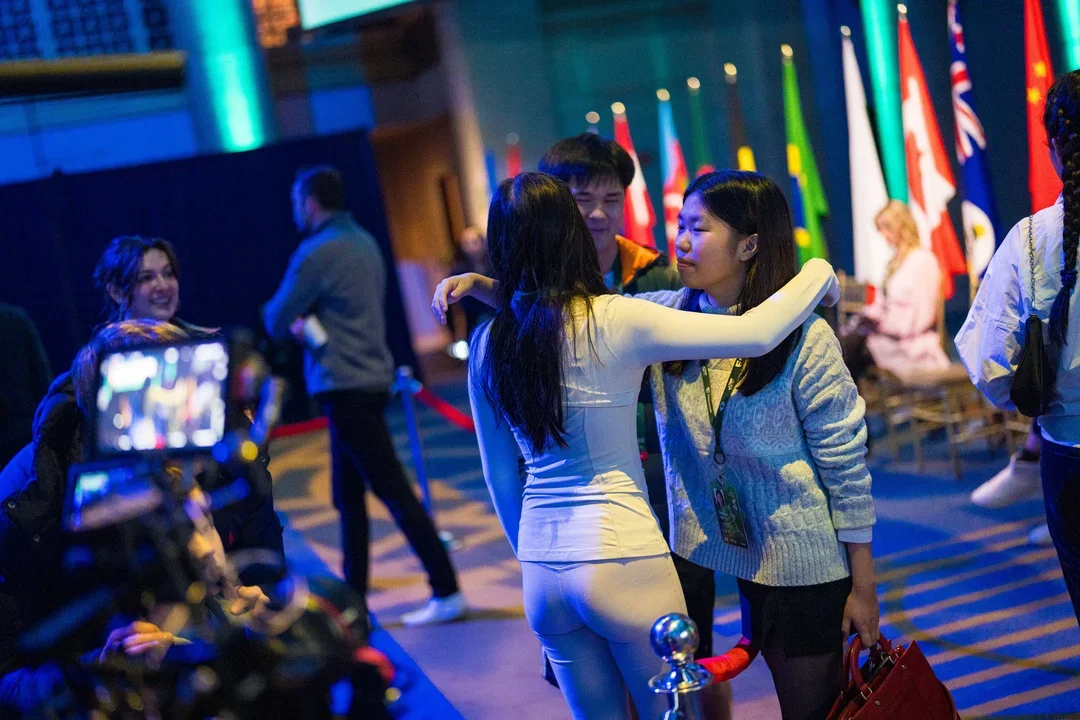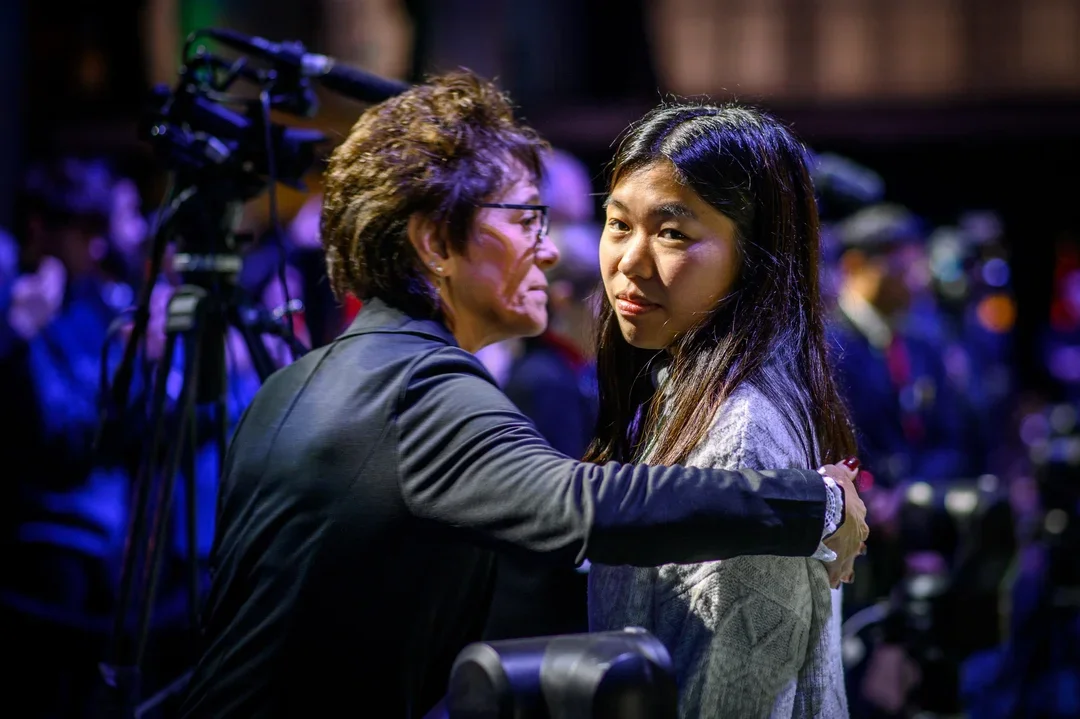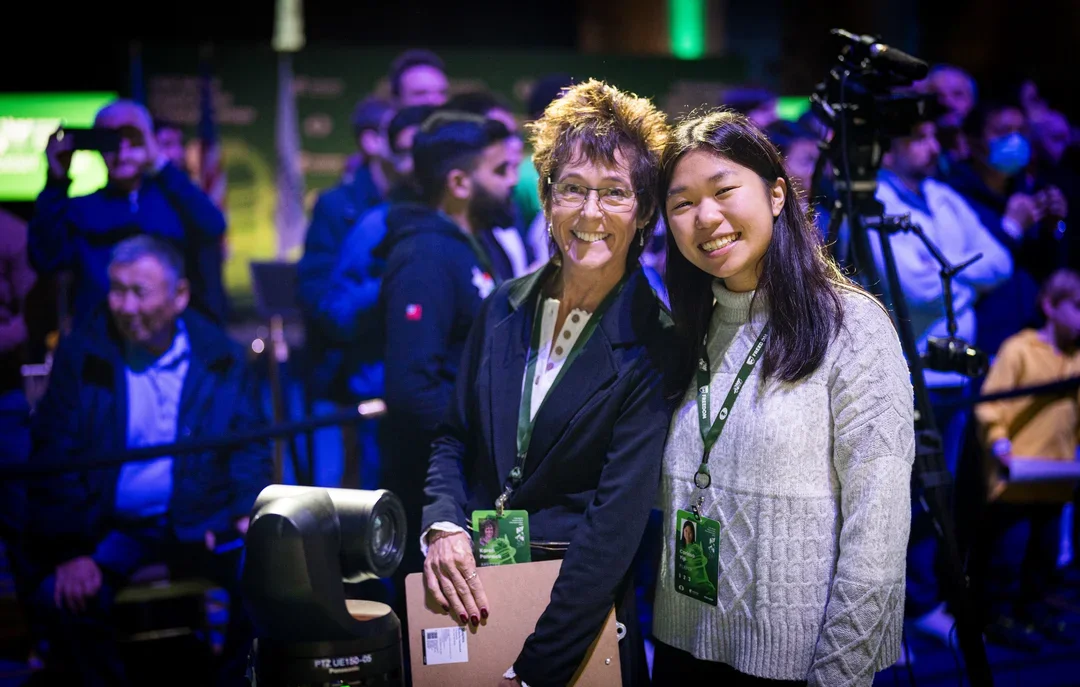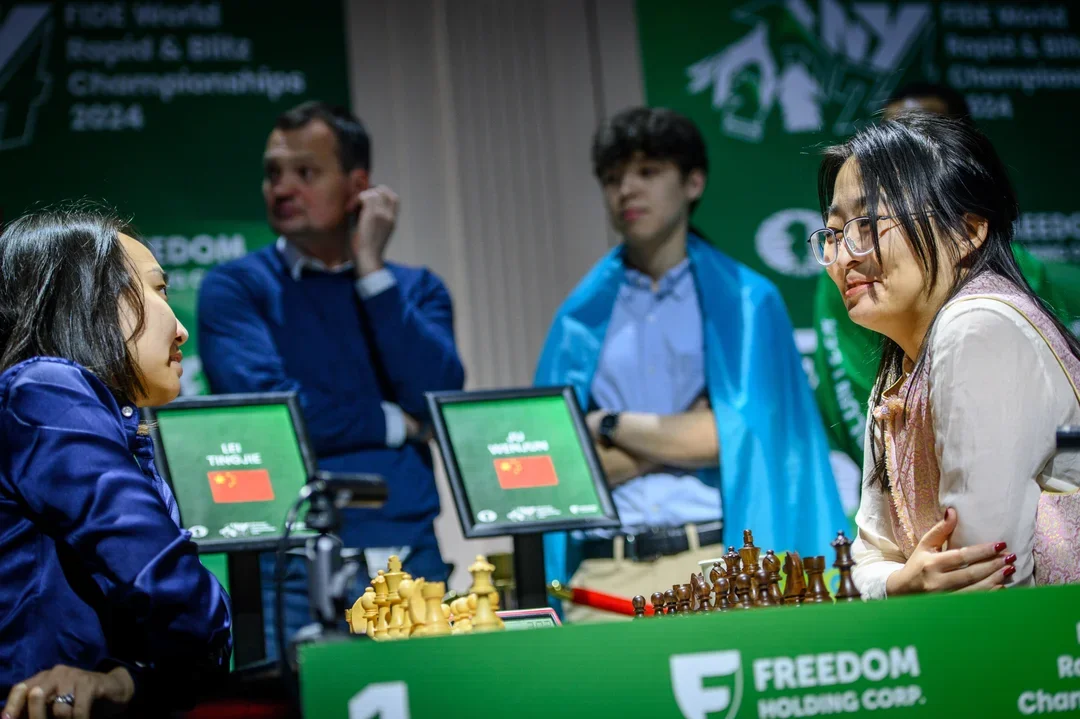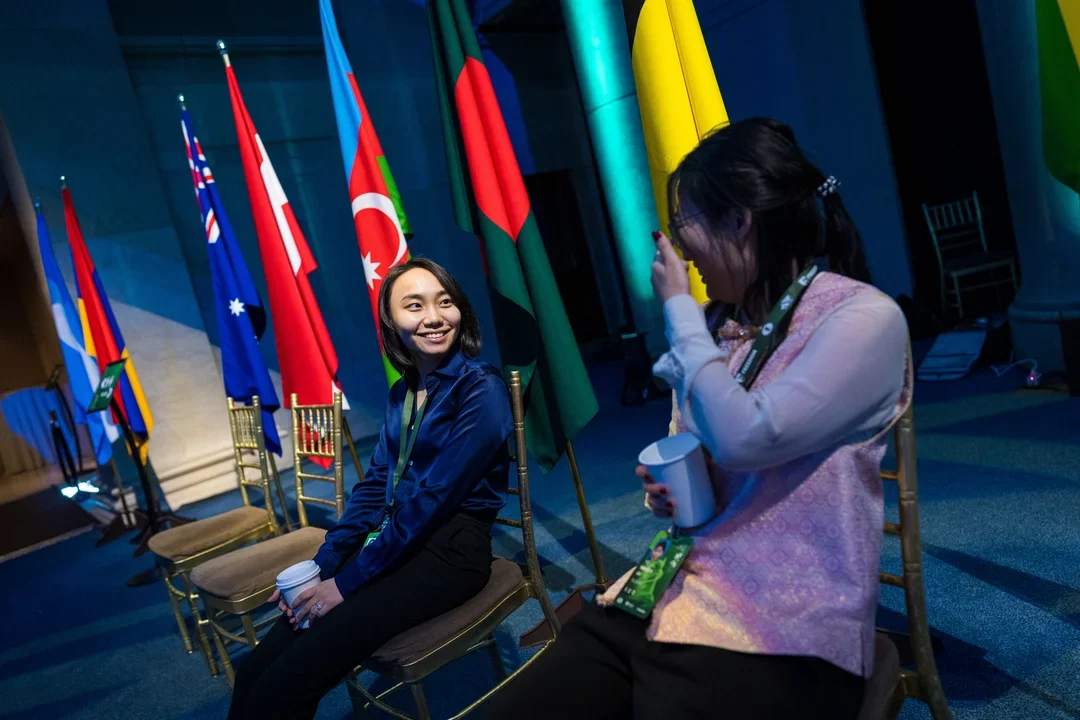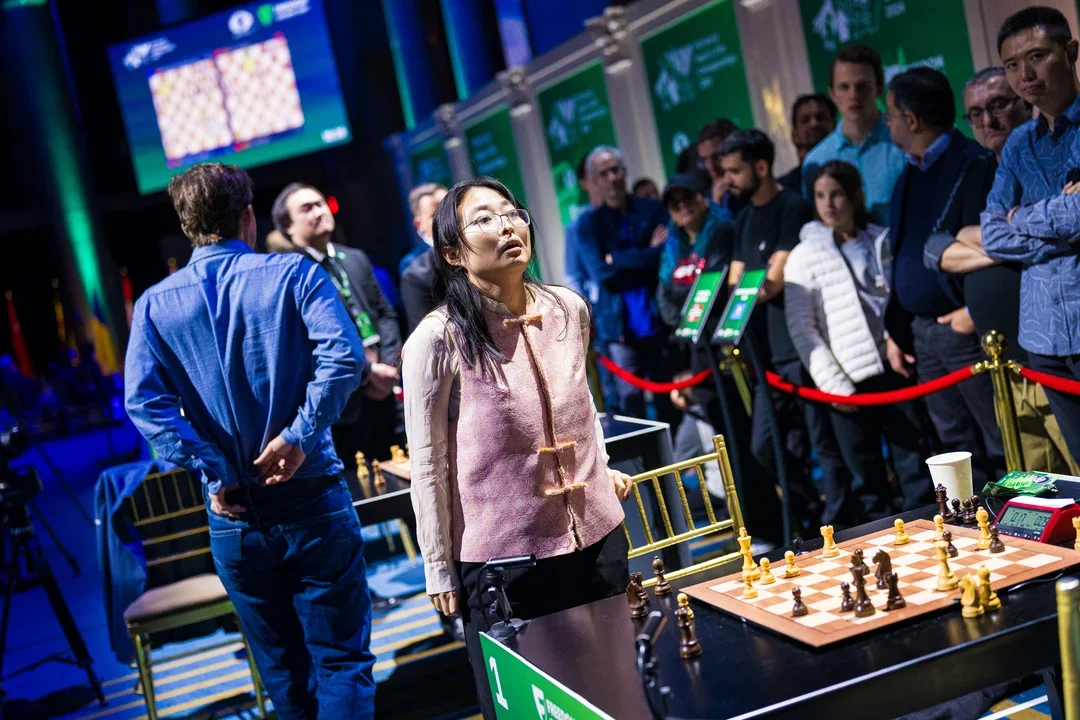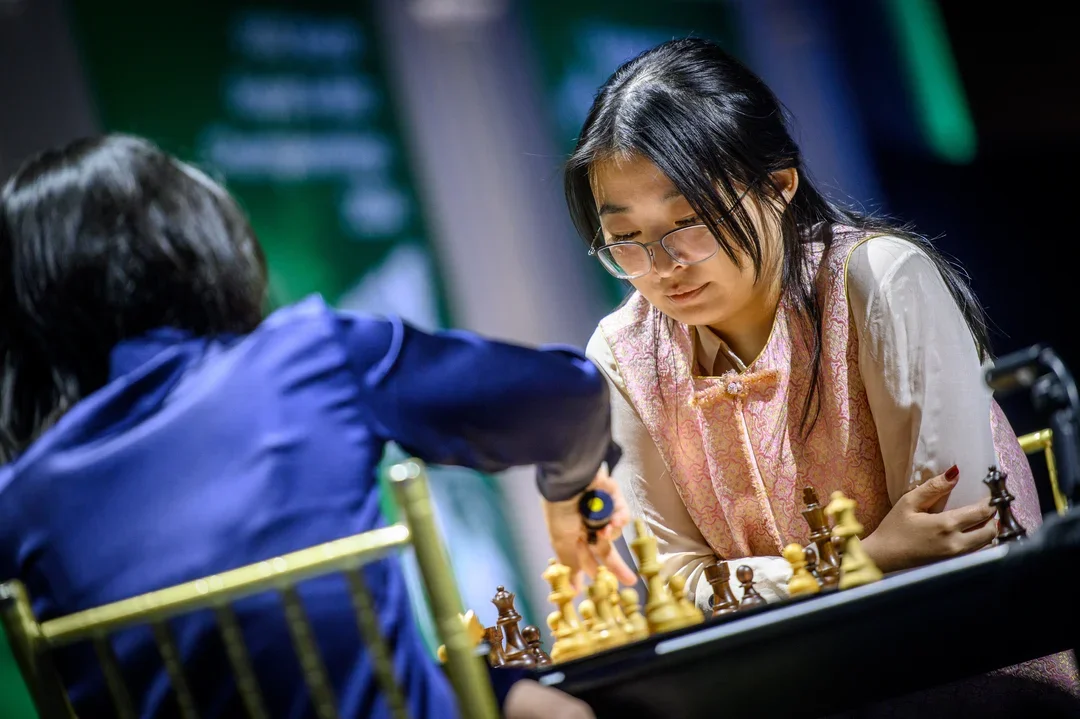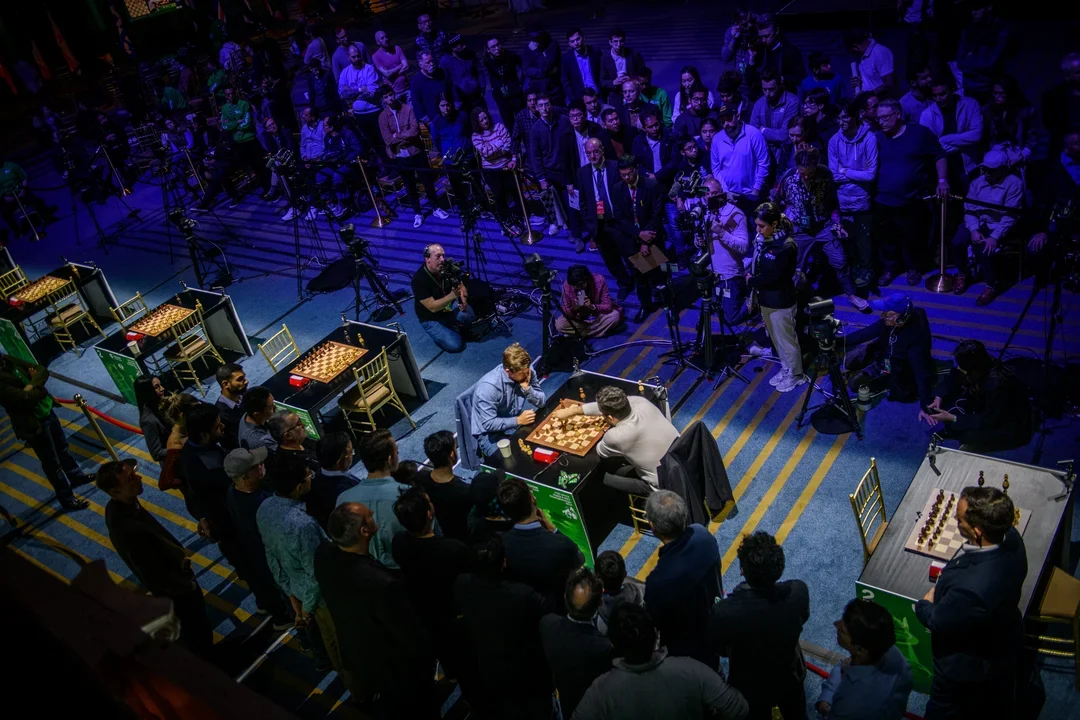One True Champion*
The 2024 FIDE World Blitz Championship featured an experimental departure in format from previous years, replacing the second day of Swiss play with an eight-player knockout featuring the top finishers from the one-day Swiss on December 30th. Several hundred fans crowded the Cipriani building on Wall Street in Manhattan, New York on New Year's Eve, all of whom were hoping to get a glimpse at some of their favorite players battle for tens of thousands of dollars and the title of World Blitz Champion.
Now, tell me, isn't it way more exciting this way? KO. Head to head. Fill or kill.
Semis start in 10 mins.— Emilchess (@EmilSutovsky) December 31, 2024
The goal: Since a world championship event should produce a world champion, the format of the World Blitz Championship should be changed as to guarantee that one true champion emerges from each section.
The reasoning: With so many rounds in the two-day Swiss format, the tournament often runs the risk of ending in a multi-way tie for first. The champion is determined by a combination of tiebreakers and/or knockout playoff matches in a way that can be disappointing to many players and fans.
The solution: Take the top eight finishers from the Swiss portion and seed them into an eight-player knockout bracket. Each round consists of four games at the same blitz time control of 3+2. If the match is tied 2–2 at the end of game four, the players play a fifth "sudden death" game with the winner advancing. If game five is a draw, they switch colors and repeat, ad infinitum, until somebody wins.
The results: let's call them mixed.
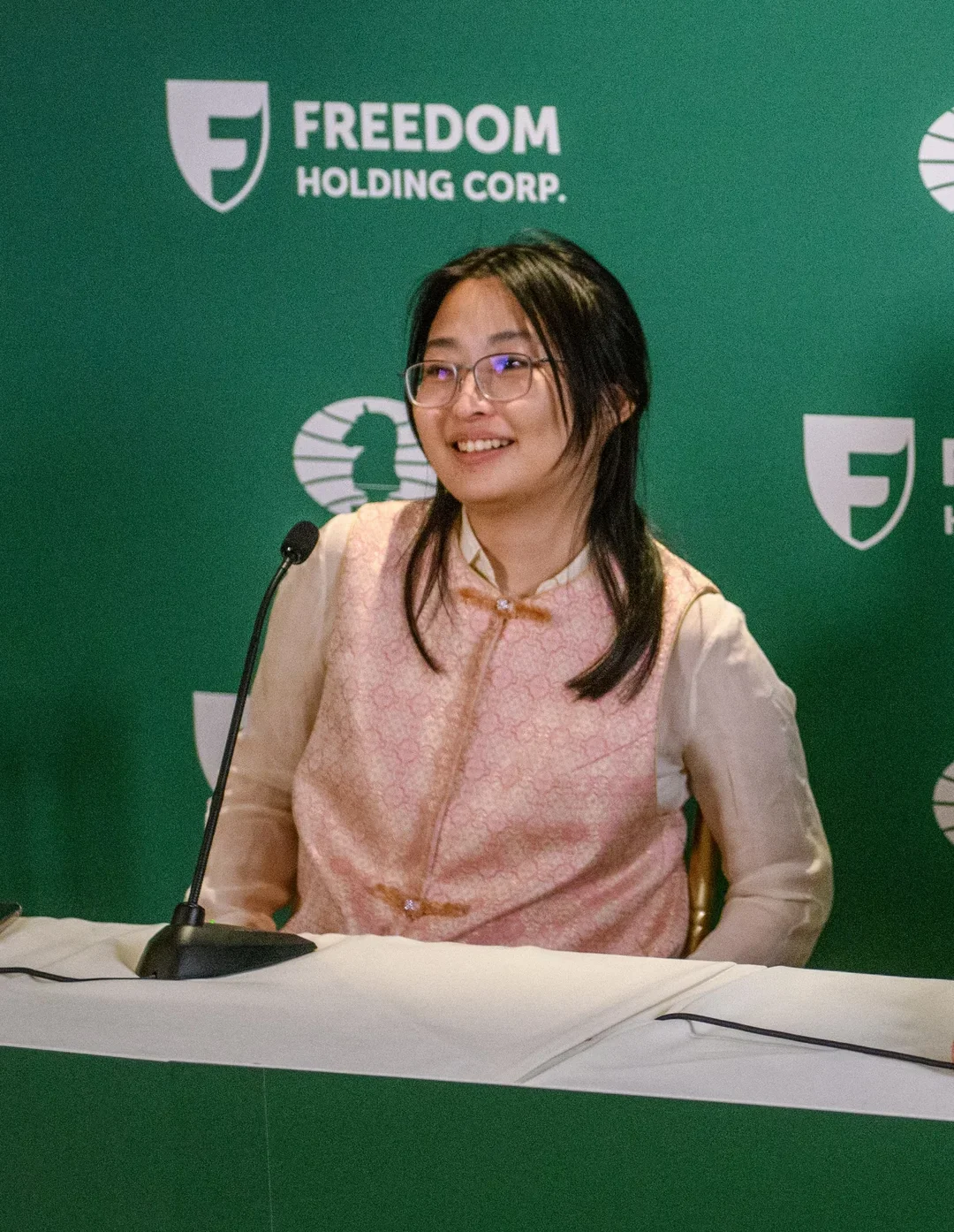
China's GM Ju Wenjun – the reigning classical World Champion — won the women's tournament over her 2023 classical challenger GM Lei Tingjie in a great fight that saw Ju emerge victorious 3½–2½ with a win in the second overtime game after five straight draws.
The match was tense and even, with neither player achieving a big advantage in any of the first five games as pressure mounted. When Ju finally converted her extra pawn in the sixth game, the playing hall broke out in applause led by the players competing in the open final. It would be hard to argue that this format produced exciting chess all day and a deserving champion.
The open was set for a similarly epic conclusion, with GMs Magnus Carlsen and Ian Nepomniachtchi tied 3½–3½ after their third overtime game ended in a draw. And then...

They stopped playing. At first, it looked like they were discussing the endgame from game seven, but discussion continued. As the crowd and commentators waited for game eight to begin, instead it dawned on everyone that the players were asking arbiters to relay a request to call the match a tie to FIDE officials.
To be fair to the players, Carlsen leapt out to a 2–0 lead only for Nepomniachtchi to roar back with consecutive wins on demand. By this point, nerves were settled and neither player was taking much risk in their overtime games. Had regulations originally specified that the title would be shared after three sudden death games, there might not have been much of a complaint from fans. And if the title was decided in an Armageddon game with draw-odds, no increment, and players knocking pieces off the board in a time scramble, at least one fan (editor's note: it's the author of this article) would have found it a depressing conclusion to a brilliant fight.
But, to be fair to the players who weren't competing in the open final, the decision to switch to this knockout format hinged on the premise of "one true champion," and it did not produce one. Almost 300 competitors were eliminated from the World Blitz after the one-day Swiss on the 30th, with many of them having had to book their hotel and flights around the possibility that they'd be playing on Tuesday only to be sitting around their hotel room, all for the sake of a tournament that produced a "true champion." And yet, a player who had already bended, broken, and ultimately changed rules earlier in the week to decide he'd be happy with a tie, so tie it is!
Many took to social media to share their disappointment, frustration, and outright confusion.
A reminder of what FIDE wanted to get out of having the Rapid and Blitz World Championship in New York: To showcase chess to potential sponsors as a serious high class sport to invest in.
— GM Jacob Aagaard (@GMJacobAagaard) January 1, 2025
FIDE should have organized a tournament tomorrow for the 200 people who got knocked out.
Something with a nice format and easy on the dress code.— Anish Giri (@anishgiri) December 31, 2024
Several pointed out that Lei might have appreciated knowing that she had the option to just request the match be called a tie before she played a gutsy opening with the black pieces to try and actually win her match.
Did the women’s section finalists know it was okay to change the tournament format during the match? What is the point of playing knockouts if sharing is acceptable?🤷🏻♀️
P.S. The women’s section had an excellent finale and a deserved winner. 👏🏼 https://t.co/J42vOrcd2s— Gulrukhbegim Tokhirjonova (@Gulruhbegim) January 1, 2025
Perhaps nobody was more impacted by the format changes before and during the event than GM Daniel Narodtisky. Naroditsky was one of ten players to finish the Swiss portion tied for first with 9½/13. But with only eight spots available for the knockout portion, FIDE used tiebreaks to eliminate the two players who opponents had the lowest average scores according to the event regulations.
If only I had known that the rules were flexible, I'd have lobbied for all 10 players who tied for first to be included in the knockout. Or, if we can have two co-champions, why not 10?! Alas...
— Daniel Naroditsky (@GmNaroditsky) January 1, 2025
In other words, the second day featured a potentially infinite number of tiebreak playoffs, but the first day could not introduce a single extra game in the event of players like Naroditsky or GM Humpy Koneru (the odd woman out in a seven-way tie for third) finishing in a tie for a top-eight spot. This isn't even getting into the reasons why GM Daniil Dubov didn't make the top eight on tiebreaks.
Next week, expect more reporting from this event highlighting performances from other top players, including a number of Americans who out-performed their ratings. But there are too many such narratives to cram into one article, and it would be a shame to see any of them overshadowed by controversy.
Women's Knockout
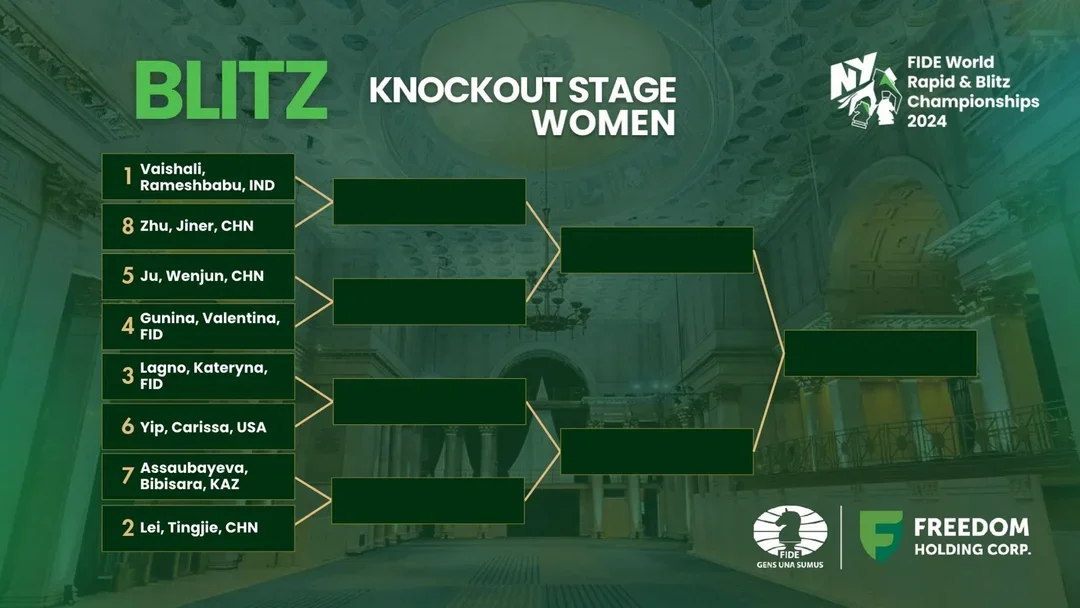
IM Carissa Yip was the only American to qualify for the women's knockout stage, and the three-time U.S. Women's Champion was set to face none other than the 2018 World Women's Champion runner-up GM Kateryna Lagno.
Calling it a battle of youth versus experience doesn't seem fair to either the 21-year-old Yip or the her 35-year-old Russian opponent. Still, this was still Yip's first World Rapid & Blitz Championship, whereas Lagno won the 2010 World Blitz Championship when Yip was seven years old.
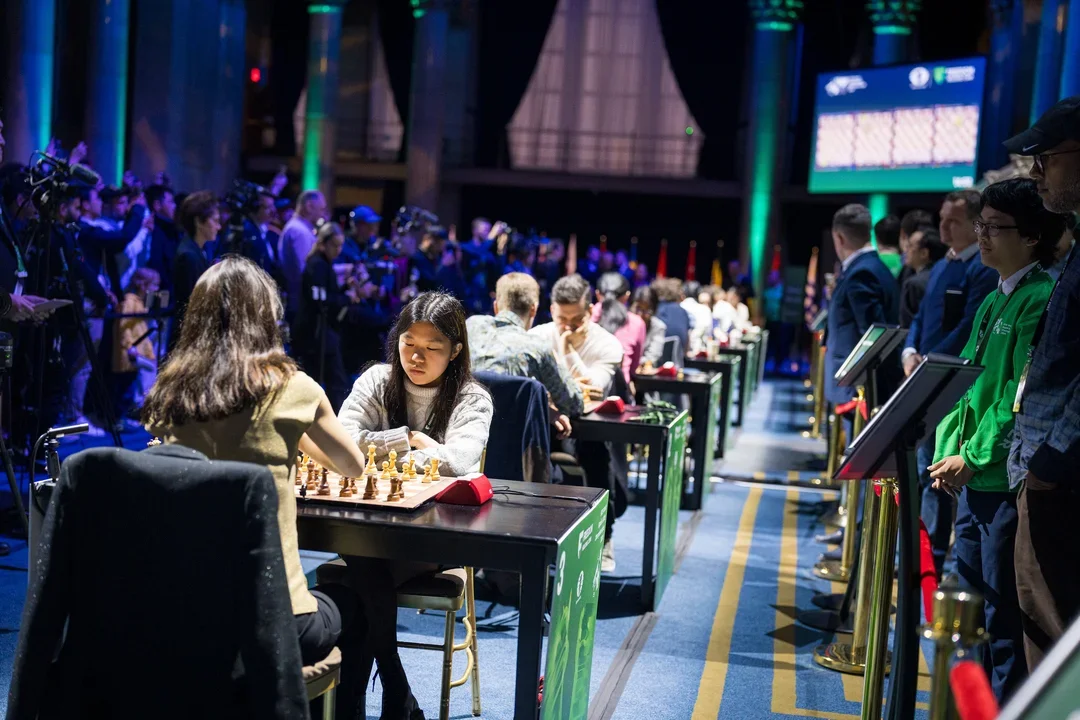
The first game started slightly shaky for Yip, who ultimately decided to sac a pawn in order to free up her pieces. But once she did, the moves started coming to her quickly while Lagno's rook started to look trapped on the open board. At one point, Yip even missed a win:
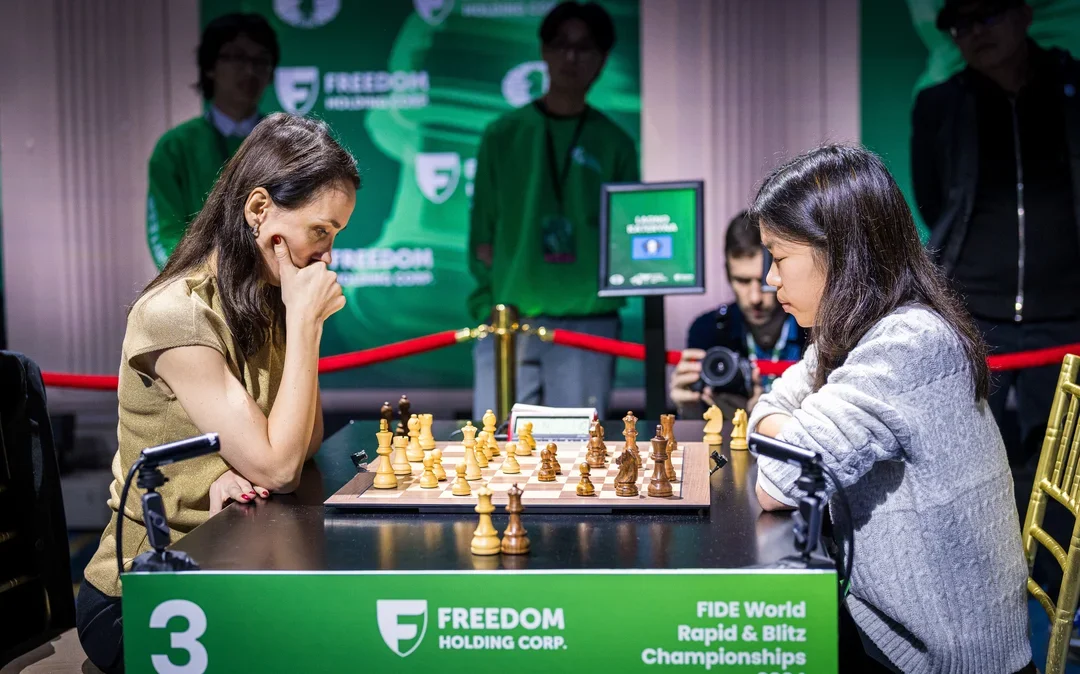
The confidence carried over to the second game, where an enterprising and rare variation of the Ruy Lopez gave Yip an easy game as soon as Lagno chose a non-critical continuation on move six. Lagno began to launch an attack out of desperation more than due to any sort of momentum, and Yip's defense was accurate at first. One miscalculation was enough, though, for Lagno to take over:
Yip had two more games to try and equalize the match, but game three would be her final attempt to win with the white pieces.
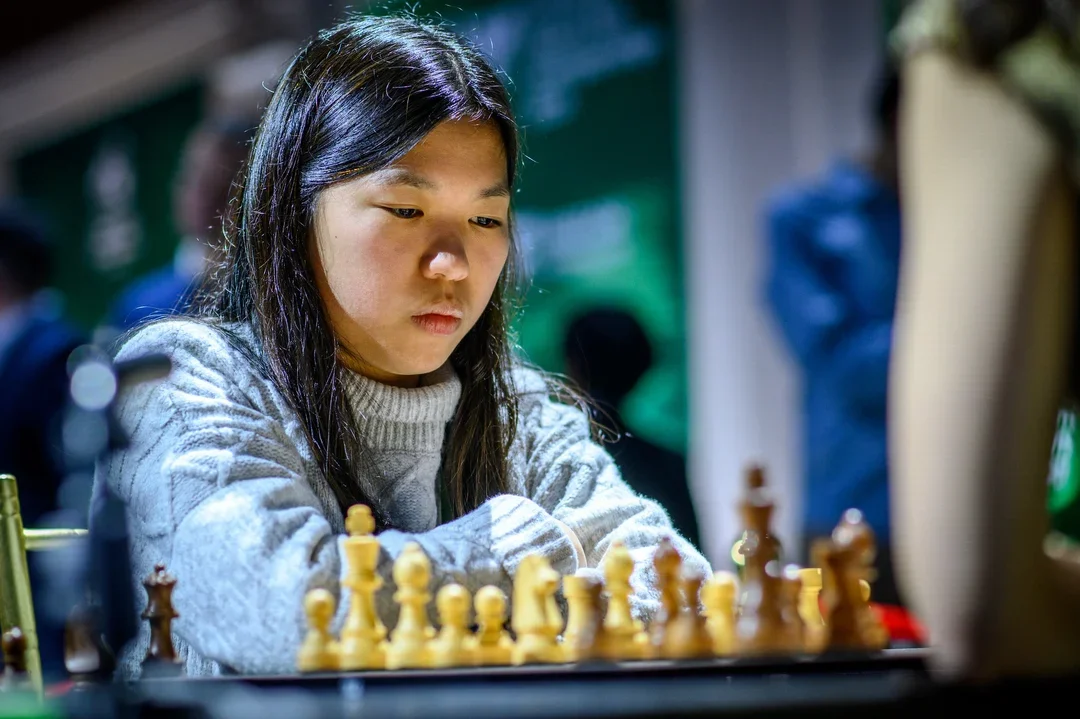
Yip got a better position out of the opening this time, and while Lagno wasn't exactly worse, it was clear that nerves and impatience were getting to her, culminating in another calculation error, this time from Lagno:
Despite being one of only two non-grandmasters in the final eight, Yip had tied the match 1½–1½ with one game to go and was proving she clearly deserved to be in such elite company.
The final game began well enough for both players, but Yip decided to go straight for a kingside attack rather than play more principled moves in the center. The position was still double-edged, but one critical decision to push her d-pawn before recentralizing her pieces gave Lagno a crushing initiative:
The loss was a disappointing end to a fantastic week of play from the Stanford undergrad. She'll be back, and we can't wait.
In the semifinals, Lagno was eliminated in double-overtime by GM Lei Tingjie 3½–2½ while Ju cruished past GM Vaishali Rameshbabu 2½–½ to set up an all-Chinese final between two old friends and Olympiad teammates.
Of course, the smiles vanished as soon as the clocks started. The match went to overtime after four solid draws so neither player willing to abandon their super-solid repertoires. Finally, in the second overtime game, Lei decided to take a risk with a gambit line of the Tarrasch Defense, and Ju was able to take the pawn and run.
In the post-game press conference, Ju insisted that her victory was due more to luck than anything else. As an example, she cited the fact that she just happened to review the line Lei tried to surprise her with earlier this week, while preparing for a totally different opponent. But if Ju is right that luck had anything to do with it, it's only that she showed us that it's even better to be both lucky and good.
Ju took home $60,000 for her victory, with Lei earning $40,000 for finishing second. Lagno and Vaishali each won $20,000, and the four remaining quarterfinalists each earned $10,000. Assuming that the regulations are to be followed as written, Humpy earned $5,000 for finishing ninth despite having the same score as the four players finishing fifth through eighth.
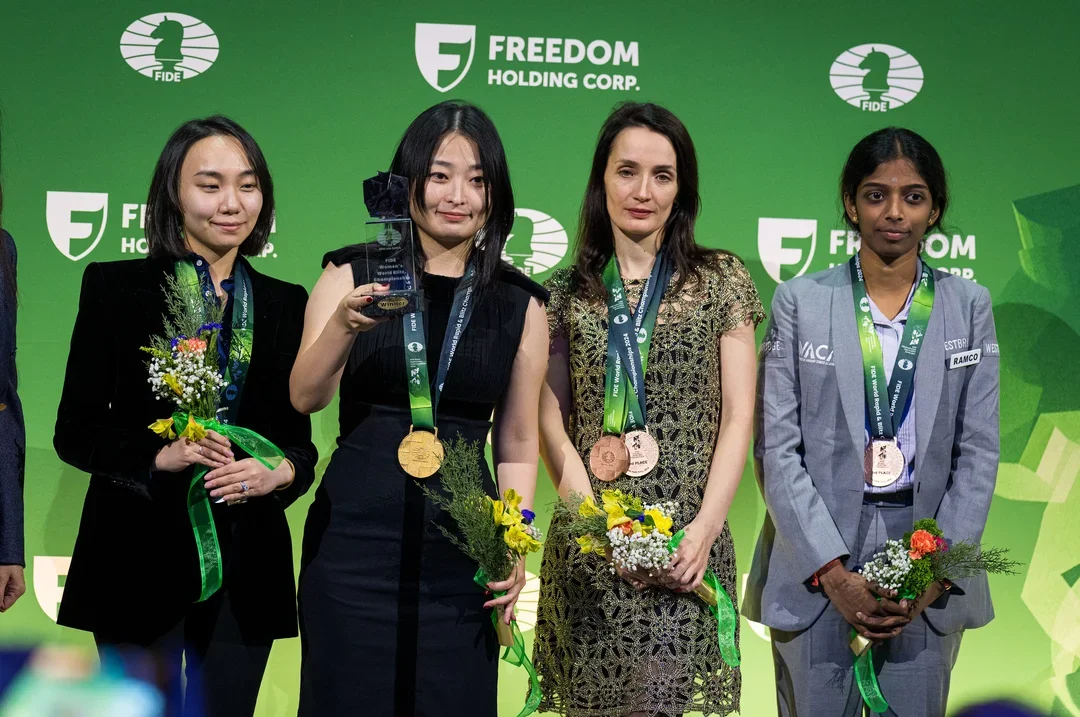
Open Knockout
All week, the organizers had the women playing in a separate venue across the street from the main playing hall. While this kept the women's games out of the spotlight, organizers also had the women's games start 15 minutes after the corresponding open games each round. The intention was to make it easier to follow games from both sections.
Yet, for the knockout, the organizers opted to have both sections share the main stage. While the intention is laudatory, the plan backfired as soon as the bracket for the open was released. Indeed, three of the four open matches got overshadowed as well. See if you can guess why:
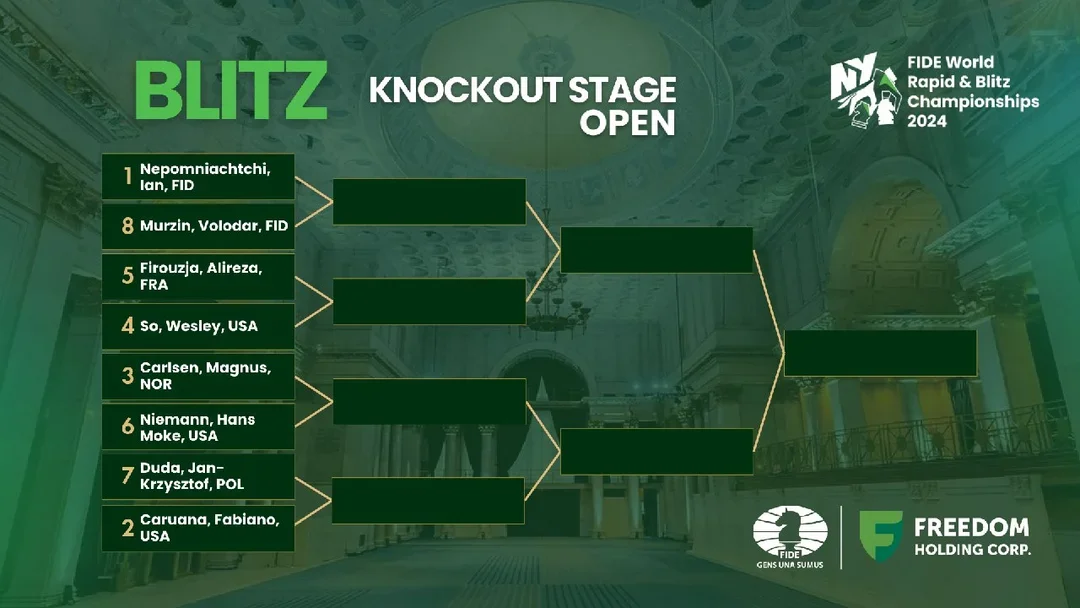
All anybody wanted to talk about in the lead-up to the knockout was the three-versus-six match-up of Carlsen and GM Hans Niemann. The feud between these players is well-documented and well-litigated. Was Magnus going to even show up? Would Hans be able to put up a fight, or would he lay an egg like in their match this past October?
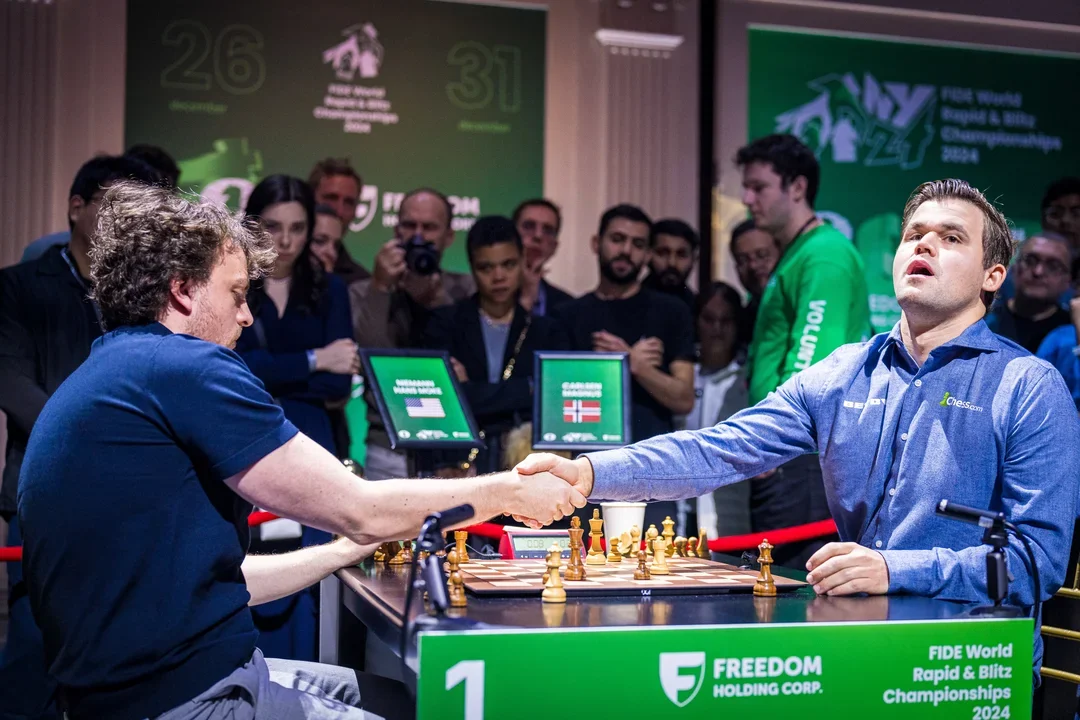
If all eyes were going to be on this pairing anyways, at least the players delivered. After drawing the first game, Hans took an early lead in round two by outplaying Magnus in his own type of game. Carlsen is known to be an endgame virtuoso, yet, in mutual time trouble, Niemann consistently found the better moves. This rattled Carlsen who, albeit from an already lost position, even blundered mate-in-one by the end. This is not how Carlsen usually gets beat.
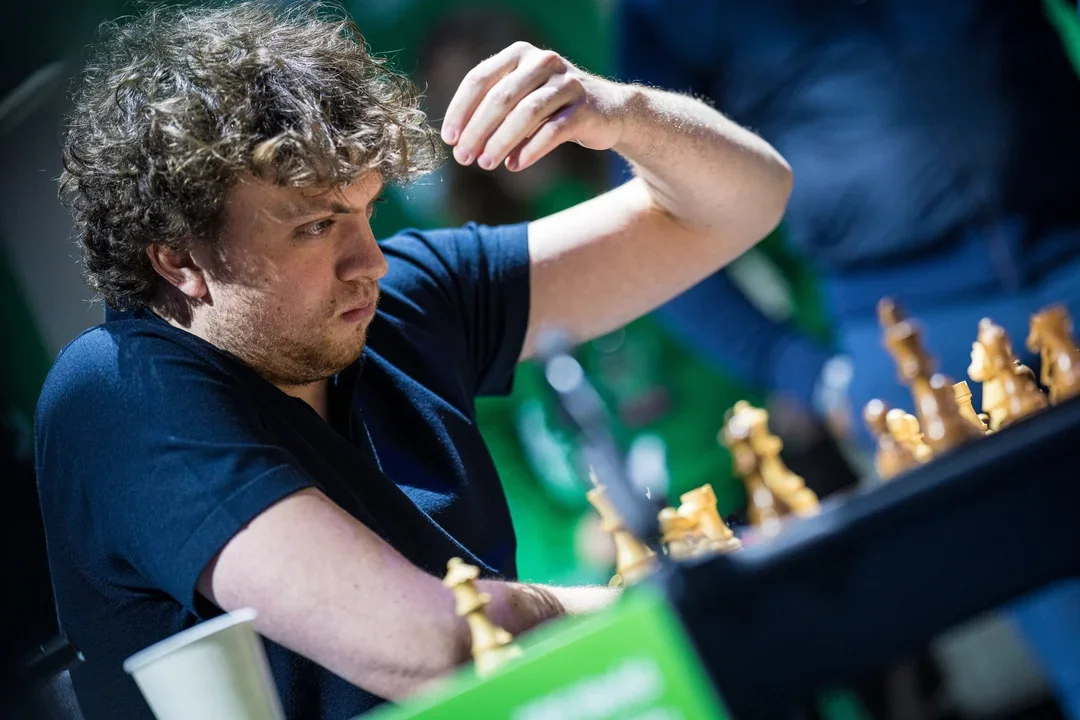
After returning the favor in game three with one shaky move that Carlsen swiftly punished, it again came down to the final blitz game. Niemann's position was fine, and Magnus was taking more time than usual. For a while, Hans was playing with over a minute on his clock while Carlsen let his time dwindle down to a few seconds. It's almost as if he was summoning every ounce of strength, as it's not like the position was one that demanded unusually deep or precise calculation. But once it was time to deliver, Carlsen delivered the type of endgame play we've become accustomed to, eliminating Niemann 2½–1½.
While clearly and understandably disappointed with the result, Niemann seemed to handle the loss well and even made some jokes at his own expense afterwards. Carlsen may have won the match, but Niemann's play is clearly continuing to rise. The 21-year-old is number 18 in the world, and, despite his best efforts, his chess is beginning to speak for itself.
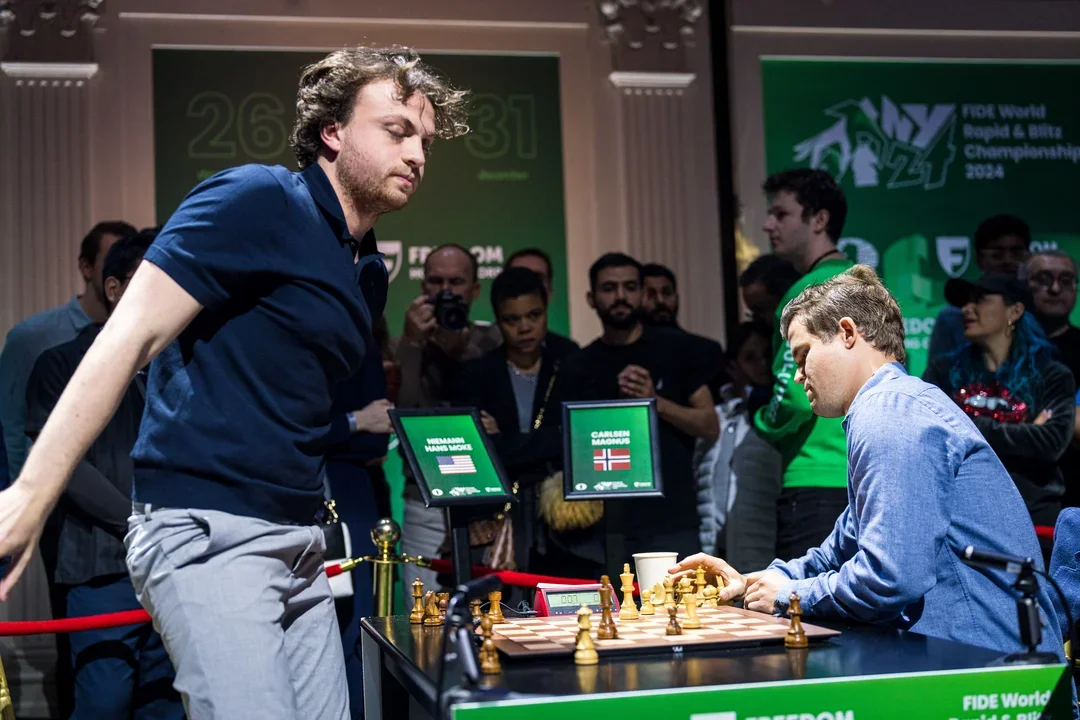
The semifinals saw Carlsen face Polish GM Jan-Krzysztof Duda and American GM Wesley So battle Nepomniachtchi. Duda was coming off a surprisingly swift 2½–½ victory over American GM Fabiano Caruana. Caruana led the Swiss for most of Monday, even getting off to a 7/7 start, so Duda's result suggested he was in good form. Yet Carlsen defeated Duda 3–0 to advance to the finals on a five-game winning streak.
Nepomniachtchi faced an early defecit against So, who was coming off an impressive victory over known blitz talent GM Alireza Firouzja in the quarterfinals.
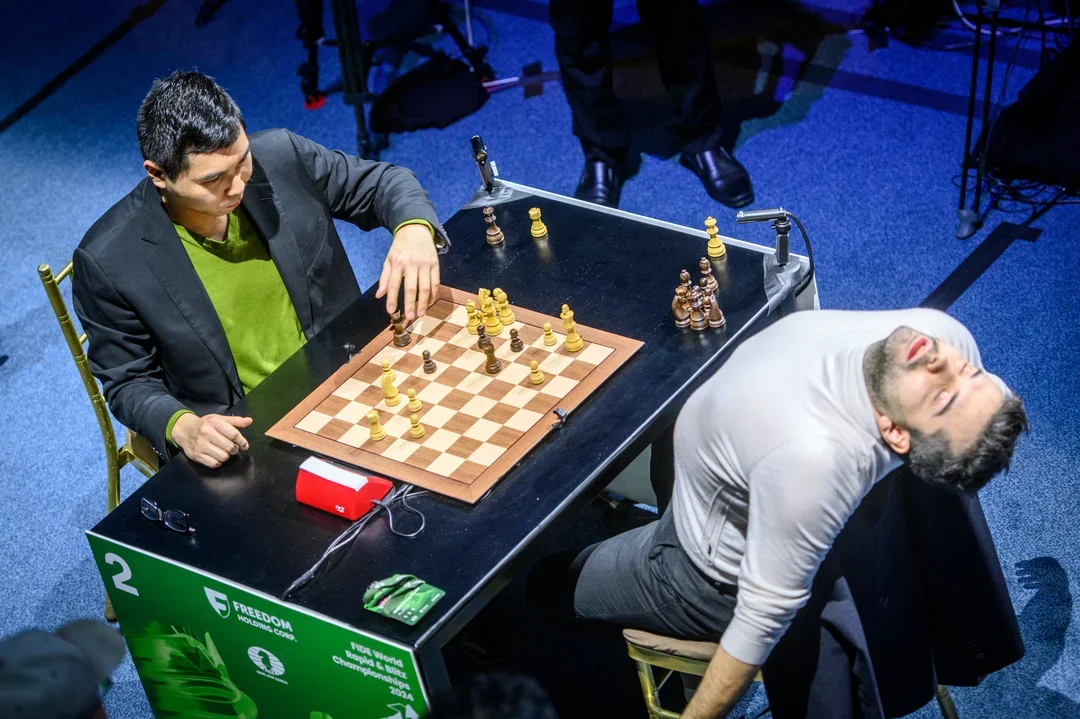
In their third game, Nepomniachtchi failed to get anything out of the opening against So, and it looked like he was going to have to win on demand with the black pieces just to tie the match. Instead, So made an uncharisteric tactical blunder that Nepomniachtchi pounced on to equalize the match:
After quickly drawing their fourth game, "Nepo" won the first overtime game to clinch the match 3–2 and set up a date with his long-time rival.
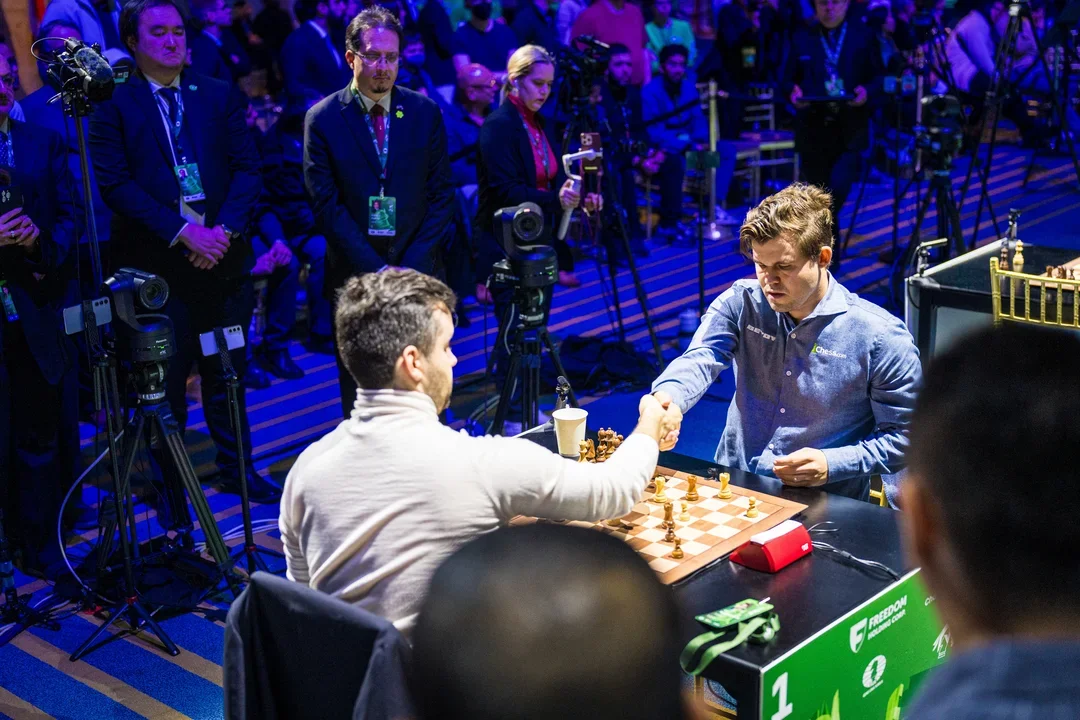
That loss to Niemann must have woke something up in Carlsen, who continued his tear through the tournament by defeating Nepomniachtchi in their first two games to extend his winning streak to seven games. His play was sharp, too, setting up a remarkable queen trap out of thin air in his second game against Nepo:
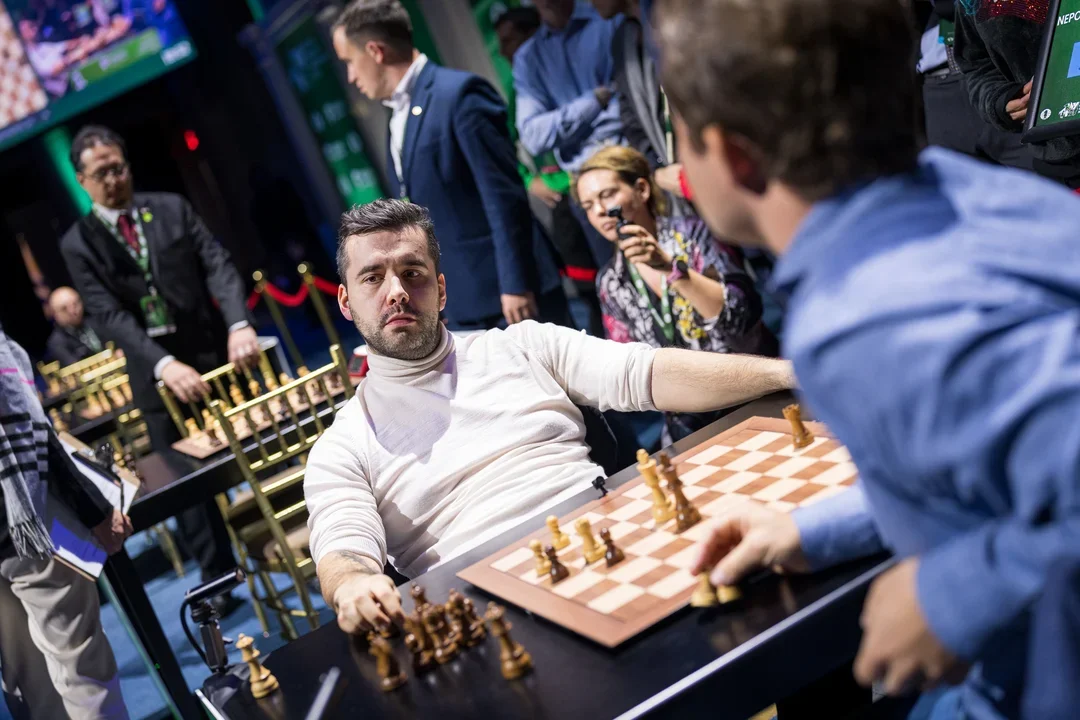
While there's no shame in losing to Carlsen, few are as familiar with the experience as Nepomniachtchi. His 2021 World Championship match against Carlsen began with five straight draws before he lost game six in 136 moves. It was the longest game in world championship history, and one that Nepo was unable to recover from, going on to lose three of the next five games.
But, first, Nepo rebounded by winning game three. Then, in game four, Carlsen seemed more interested in playing for an emphatic victory to end his tournament than in simply trying to escape with a draw. Against a lesser player, this might have worked. But Nepomniachtchi showed why he has been one Carlsen's most formidable rivals:
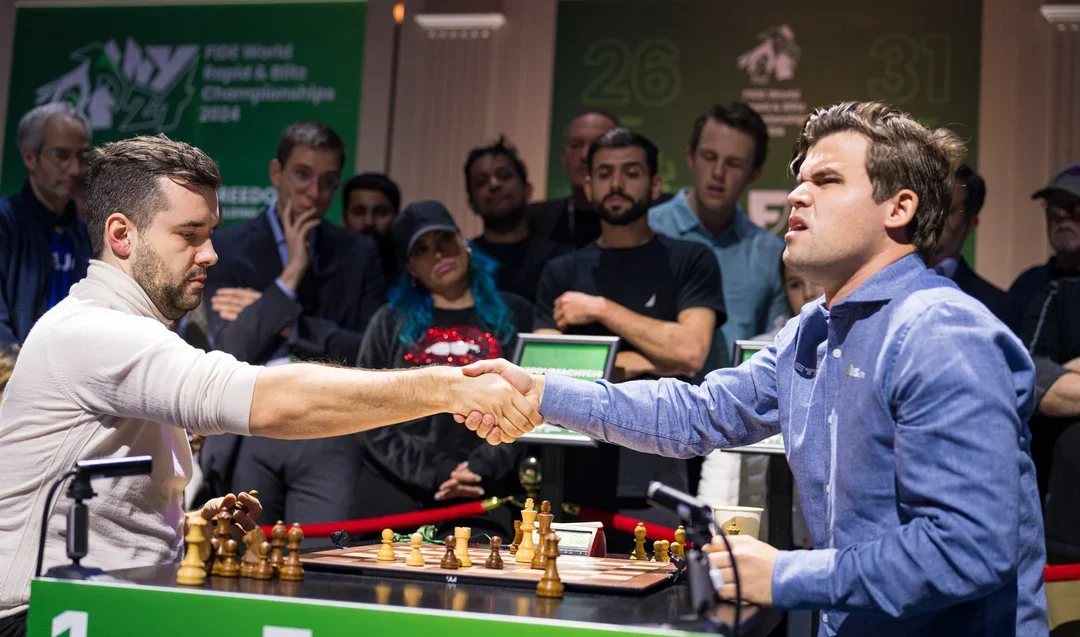
With the match tied 2–2, the players went on to the first sudden death game. Then the second, and then the third. The rest, for better or worse, is history.
The co-champions presumably each took home $80,000 dollars, with Carlsen seemingly getting his way in insisting that Nepomniachtchi take home the trophy. Duda and So each earned $42,000 and the four remaining quarterfinalists each earned $20,000. Naroditsky and Dubov presumably each took home $10,000 by tying for ninth and tenth place, despite having the same score on Monday as the eight participants in Tuesday's knockout.
Quick Links
Categories
Archives
- December 2025 (8)
- November 2025 (29)
- October 2025 (39)
- September 2025 (27)
- August 2025 (29)
- July 2025 (43)
- June 2025 (25)
- May 2025 (24)
- April 2025 (29)
- March 2025 (29)
- February 2025 (20)
- January 2025 (24)
- December 2024 (34)
- November 2024 (18)
- October 2024 (35)
- September 2024 (23)
- August 2024 (27)
- July 2024 (44)
- June 2024 (27)
- May 2024 (31)
- April 2024 (51)
- March 2024 (34)
- February 2024 (25)
- January 2024 (26)
- December 2023 (29)
- November 2023 (26)
- October 2023 (37)
- September 2023 (27)
- August 2023 (37)
- July 2023 (47)
- June 2023 (33)
- May 2023 (37)
- April 2023 (45)
- March 2023 (37)
- February 2023 (28)
- January 2023 (31)
- December 2022 (23)
- November 2022 (32)
- October 2022 (31)
- September 2022 (19)
- August 2022 (39)
- July 2022 (32)
- June 2022 (35)
- May 2022 (21)
- April 2022 (31)
- March 2022 (33)
- February 2022 (21)
- January 2022 (27)
- December 2021 (36)
- November 2021 (34)
- October 2021 (25)
- September 2021 (25)
- August 2021 (41)
- July 2021 (36)
- June 2021 (29)
- May 2021 (29)
- April 2021 (31)
- March 2021 (33)
- February 2021 (28)
- January 2021 (29)
- December 2020 (38)
- November 2020 (40)
- October 2020 (41)
- September 2020 (35)
- August 2020 (38)
- July 2020 (36)
- June 2020 (46)
- May 2020 (42)
- April 2020 (37)
- March 2020 (60)
- February 2020 (38)
- January 2020 (45)
- December 2019 (34)
- November 2019 (35)
- October 2019 (42)
- September 2019 (45)
- August 2019 (56)
- July 2019 (44)
- June 2019 (35)
- May 2019 (40)
- April 2019 (48)
- March 2019 (61)
- February 2019 (39)
- January 2019 (30)
- December 2018 (29)
- November 2018 (51)
- October 2018 (45)
- September 2018 (29)
- August 2018 (49)
- July 2018 (35)
- June 2018 (31)
- May 2018 (39)
- April 2018 (31)
- March 2018 (26)
- February 2018 (33)
- January 2018 (30)
- December 2017 (26)
- November 2017 (24)
- October 2017 (30)
- September 2017 (30)
- August 2017 (31)
- July 2017 (28)
- June 2017 (32)
- May 2017 (26)
- April 2017 (37)
- March 2017 (28)
- February 2017 (30)
- January 2017 (27)
- December 2016 (29)
- November 2016 (24)
- October 2016 (32)
- September 2016 (31)
- August 2016 (27)
- July 2016 (24)
- June 2016 (26)
- May 2016 (19)
- April 2016 (30)
- March 2016 (36)
- February 2016 (28)
- January 2016 (32)
- December 2015 (26)
- November 2015 (23)
- October 2015 (16)
- September 2015 (28)
- August 2015 (28)
- July 2015 (6)
- June 2015 (1)
- May 2015 (2)
- April 2015 (1)
- February 2015 (3)
- January 2015 (1)
- December 2014 (1)
- July 2010 (1)
- October 1991 (1)
- August 1989 (1)
- January 1988 (1)
- December 1983 (1)


